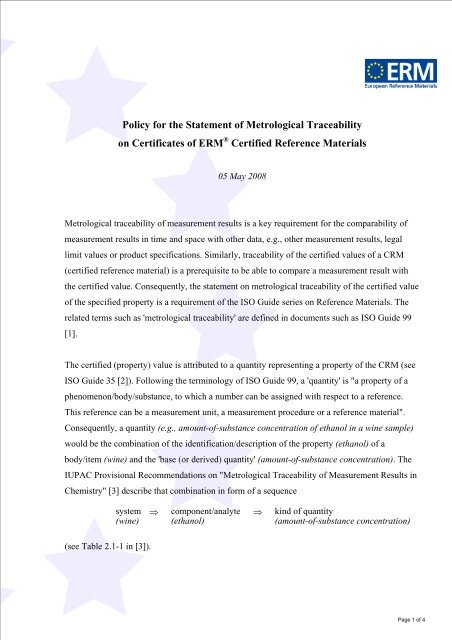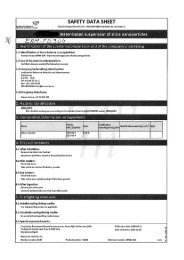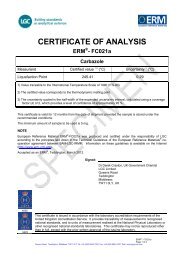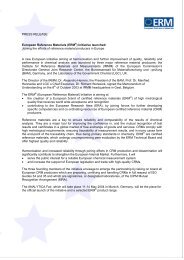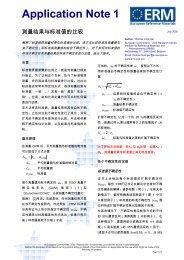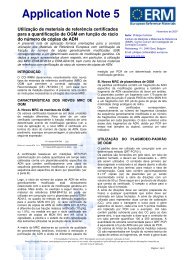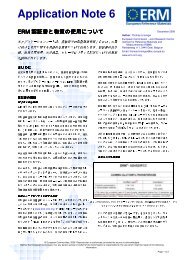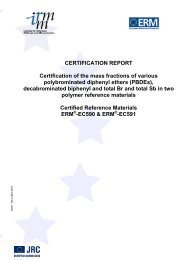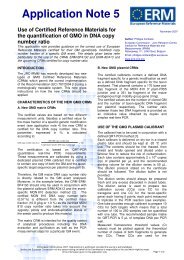Certificate of - European Reference Materials
Certificate of - European Reference Materials
Certificate of - European Reference Materials
Create successful ePaper yourself
Turn your PDF publications into a flip-book with our unique Google optimized e-Paper software.
Policy for the Statement <strong>of</strong> Metrological Traceability<br />
on <strong>Certificate</strong>s <strong>of</strong> ERM ® Certified <strong>Reference</strong> <strong>Materials</strong><br />
05 May 2008<br />
Metrological traceability <strong>of</strong> measurement results is a key requirement for the comparability <strong>of</strong><br />
measurement results in time and space with other data, e.g., other measurement results, legal<br />
limit values or product specifications. Similarly, traceability <strong>of</strong> the certified values <strong>of</strong> a CRM<br />
(certified reference material) is a prerequisite to be able to compare a measurement result with<br />
the certified value. Consequently, the statement on metrological traceability <strong>of</strong> the certified value<br />
<strong>of</strong> the specified property is a requirement <strong>of</strong> the ISO Guide series on <strong>Reference</strong> <strong>Materials</strong>. The<br />
related terms such as 'metrological traceability' are defined in documents such as ISO Guide 99<br />
[1].<br />
The certified (property) value is attributed to a quantity representing a property <strong>of</strong> the CRM (see<br />
ISO Guide 35 [2]). Following the terminology <strong>of</strong> ISO Guide 99, a 'quantity' is "a property <strong>of</strong> a<br />
phenomenon/body/substance, to which a number can be assigned with respect to a reference.<br />
This reference can be a measurement unit, a measurement procedure or a reference material".<br />
Consequently, a quantity (e.g., amount-<strong>of</strong>-substance concentration <strong>of</strong> ethanol in a wine sample)<br />
would be the combination <strong>of</strong> the identification/description <strong>of</strong> the property (ethanol) <strong>of</strong> a<br />
body/item (wine) and the 'base (or derived) quantity' (amount-<strong>of</strong>-substance concentration). The<br />
IUPAC Provisional Recommendations on "Metrological Traceability <strong>of</strong> Measurement Results in<br />
Chemistry" [3] describe that combination in form <strong>of</strong> a sequence<br />
(see Table 2.1-1 in [3]).<br />
system ⇒ component/analyte ⇒ kind <strong>of</strong> quantity<br />
(wine) (ethanol) (amount-<strong>of</strong>-substance concentration)<br />
Page 1 <strong>of</strong> 4
A certified value on a CRM certificate belongs to a specified quantity and is the combination <strong>of</strong> a<br />
number (with its uncertainty) and the measurement unit.<br />
Therefore, the key information on page 1 <strong>of</strong> an ERM CRM certificate is actually a combination<br />
<strong>of</strong> 5 attributes:<br />
• Identification <strong>of</strong> the body/matrix (e.g., wine)<br />
• Identification/description <strong>of</strong> the property/component (e.g., ethanol)<br />
• Description <strong>of</strong> the certified base or derived quantity/kind-<strong>of</strong>-quantity (e.g., amount-<strong>of</strong>substance<br />
concentration)<br />
• A number (e.g., 3.8 – with its corresponding uncertainty (e.g., ± 0.1)<br />
• The measurement unit (e.g., mol/L)<br />
The combination <strong>of</strong> these attributes has to be covered by the "traceability statement". When<br />
preparing a traceability statement, one should take into consideration (according to ISO Guide<br />
99) that 'metrological traceability' sets a requirement on the 'measurement result', which itself is<br />
defined as "quantity value(s) being attributed to a measurand" (with 'measurand' as the "quantity<br />
intended to be measured"). The 'quantity value' is the product <strong>of</strong> a number (with its uncertainty)<br />
and a measurement unit.<br />
The measurement result has to be related to a stated reference and (as described in ISO Guide<br />
99) such a stated reference can be:<br />
− a value defined by the definition <strong>of</strong> a measurement unit or<br />
− a value realized by a measurement procedure (including the measurement unit for a nonordinal<br />
quantity) or<br />
− a value carried by a measurement standard (i.e., a certified reference material).<br />
Page 2 <strong>of</strong> 4
For most <strong>of</strong> the quantities described on CRM certificates, one (or both) <strong>of</strong> the following cases<br />
have to be considered:<br />
− a measurand (quantity) which is defined by its structure alone (e.g., a chemical entity<br />
such as a specific ion, atom, molecule) or<br />
− a measurand (quantity) which is operationally defined by a described measurement<br />
procedure.<br />
Obviously the certified value as the mathematical product <strong>of</strong> a number and the measurement unit<br />
has to be derived via properly calibrated measurement systems and it is this calibration hierarchy<br />
that needs to be described. As this is usually too much information to be inserted on the first<br />
page <strong>of</strong> a CRM certificate (and possibly even on the certificate at all), this description <strong>of</strong> the<br />
traceability hierarchy should be abbreviated in a footnote accompanying the term "certified<br />
value" on page 1 <strong>of</strong> the ERM CRM certificate as indicated here. Although not mandatory for an<br />
ERM CRM, the certification report is the best place to deliver all information concerning<br />
metrological traceability and calibration hierarchies.<br />
The following principles for the traceability statements on ERM CRM certificates (and ERM<br />
certification reports) should be followed:<br />
1. For "structurally defined" measurands quantified in total:<br />
− Matrix (e.g., wine): no footnote required<br />
− Certified property (e.g., ethanol): no footnote required<br />
− Certified (kind <strong>of</strong>) quantity (e.g., amount-<strong>of</strong>-substance concentration): no footnote<br />
required<br />
− Certified value (e.g., 3.8 mol/L): footnotes stating the statistical parameters used for the<br />
certified value(s) (e.g., unweighted mean <strong>of</strong>…) and stating the metrological traceability <strong>of</strong><br />
these values, typically as "It is traceable to the International System <strong>of</strong> Units (SI)."<br />
− Uncertainty (e.g., 0.1 mol/L): footnote stating the type <strong>of</strong> uncertainty value given (e.g.,<br />
expanded uncertainty estimated in accordance with the GUM with a coverage factor 2<br />
corresponding to a level <strong>of</strong> confidence <strong>of</strong> about 95 %).<br />
Page 3 <strong>of</strong> 4
The calibration hierarchy should be described in the certification report (or on subsequent pages<br />
<strong>of</strong> the certificate), whereby the principle, including reference to the most important calibrants,<br />
should be given and a reasonable level <strong>of</strong> detail is recommended.<br />
2. For "operationally/method defined" measurands:<br />
− Matrix (e.g., sandy soil): no footnote required<br />
− Certified property (e.g., extractable PCB 153): Footnote required stating the definition <strong>of</strong><br />
the property, typically like "as defined by the procedure according to ISO 12345" or:<br />
"as obtained by Soxhlet extraction and subsequent quantification by GC-MS"<br />
− Certified (kind <strong>of</strong>) quantity (e.g., mass fraction): no footnote required<br />
− Certified value (e.g., 5.3 μg/kg): footnotes stating the statistical parameters used for the<br />
certified value(s) (e.g., unweighted mean <strong>of</strong>…) and stating the metrological traceability <strong>of</strong><br />
these values, typically as "It is traceable to the International System <strong>of</strong> Units (SI)."<br />
− Uncertainty (e.g., 0.1 μg/kg): footnote stating the type <strong>of</strong> uncertainty value given (e.g.,<br />
expanded uncertainty estimated in accordance with the GUM with a coverage factor 2<br />
corresponding to a level <strong>of</strong> confidence <strong>of</strong> about 95 %).<br />
Again the applied calibration hierarchies should be described in the certification report (or on<br />
subsequent pages <strong>of</strong> the certificate), whereby the principle, including reference to the most<br />
important calibrants, should be given and a reasonable level <strong>of</strong> detail is recommended.<br />
<strong>Reference</strong>s:<br />
[1] ISO/IEC Guide 99 "International vocabulary <strong>of</strong> metrology – basic and general concepts and<br />
associated terms (VIM), ISO, Geneva (2007)<br />
[2] ISO Guide 35 "<strong>Reference</strong> materials – general and statistical principles for certification",<br />
3 rd edition, ISO, Geneva (2006)<br />
[3] http://www.iupac.org/reports/provisional/abstrac07/fajgelji_draft_2007-09-18.pdf<br />
Hendrik Emons<br />
On behalf <strong>of</strong> the ERM cooperation<br />
Page 4 <strong>of</strong> 4


